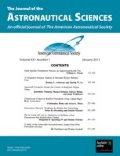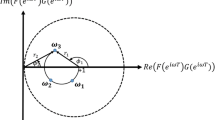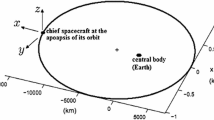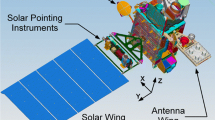Abstract
Spacecraft often experience jitter from reaction wheels, control moment gyros (CMGs), or from motion of other internal parts. One may isolate fine pointing equipment by passive techniques, but active vibration control employing knowledge of the periodic nature of jitter can improve performance. Previous work by the authors and co-workers tested active isolation using a 6 degree-of-freedom Stewart platform. A new class of applications is laser communication relay satellites, which replaces radio frequencies communication by laser communications. Laser beam jitter can be corrected by control of tip and tilt in fast steering mirrors. This paper develops experiments testing five candidate jitter cancellation algorithms on the Bifocal Relay Mirror Spacecraft, Three Axis Simulator 2 testbed at the Naval Postgraduate School. Jitter results from the CMGs. Multiple period repetitive control (MPRC) and matched basis function repetitive control (MBFRC) are tested. Both use disturbance period information from Hall effect sensors for the CMG three phase brushless DC motors. Filtered-X LMS, adaptive linear model predictive control, and the Clear Box algorithm with Adaptive Basis Method are also tested. The best disturbance rejection resulted from the last of these choices, with a 66 % overall amplitude reduction. Concerning MPRC it was discovered that repeating an addressed period can be used as a technique to decrease sensitivity to accurate knowledge of the disturbance period.









































Similar content being viewed by others
References
Edwards, S.G., Agrawal, B.N., Phan, M.Q., Longman, R.W.: Disturbance identification and rejection experiments on an ultra quiet platform. Adv. Astronaut. Sci. 103, 633–651 (1999)
Kim, J.J., Sand, T., Agrawal, B.N: Acquisition, tracking, and pointing technology development for bifocal relay mirror spacecraft. Proc. SPIE. 6569, 656907–1 (2007)
Tomizuka, M., Tsao, T.-C., Chew, K.K.: Analysis and synthesis of discrete time repetitive controllers. J. Dyn. Syst. Meas. Control. 111, 353–358 (1989)
Longman, R.W.: On the theory and design of linear repetitive control systems. In: Ahn, H.-S. (ed.) European journal of control, special section on iterative learning control, vol. 16, No. 5, pp. 447–496 (2010)
Yamada, M., Riadh, Z., Funahashi, Y.: Design of robust repetitive control system for multiple periods. In: Proceedings of the 39th IEEE Conference on Decision and Control, pp. 3739–3744 (2000)
Yamada, M., Riadh, Z., Funahashi, Y.: Discrete-time repetitive control systems with multiple periods. In: Proceedings of 6th International Workshop on Advanced Motion Control, pp. 228–233 (2000)
Longman, R.W., Yeol, J.W., Ryu, Y.S.: Improved methods to cancel multiple unrelated periodic disturbances by repetitive control. Adv. Astronaut. Sci. 123, 199–218 (2006)
Longman, R.W., Yeol, J.W., Ryu, Y.S.: Tuning and performance of robust multiple-period repetitive control. Adv. Astronaut. Sci. 124, 687–705 (2006)
Ahn, E.S., Longman, R.W., Kim, J.J.: Evaluating the stability robustness to model errors of multiple-period repetitive control. Adv. Astronaut. Sci. 142, 2563–2580 (2012)
Nagashima, M., Longman, R.W.: Stability and performance analysis of matched basis function repetitive control in the frequency domain. Adv. Astronaut. Sci. 119, 1581–1600 (2005)
Shi, Y., Longman, R.W., Nagashima, M.: Small gain stability theory for matched basis function repetitive control. In: Proceedings of the first IAA Conference on Dynamics and Control of Space Systems. Porto Portugal, to appear in Advances in the Astronautical Sciences (2012)
Elliott, S.J., Stothers, I.M., Nelson, P.A.: A multiple error LMS algorithm and its application to the active control of sound and vibration. IEEE Trans. Acoust. Signal Process. 25(6), 484–491 (1977)
Haykin, S.: Adaptive Filter Theory, Fourth Edition. Prentice-Hall, Upper Saddle River, NJ (1985)
Kuo, S.M., Morgan, D.R.: Active Noise Control Systems. Wiley, New York (1996)
Darling, R.S., Phan, M.Q.: Predictive controllers for simultaneous tracking and disturbance rejection. In: AIAA Guidance, Navigation, and Control Conference and Exhibit 16-19. Providence, Rhode Island (2004)
Eure, K.W., Juang, J.-N.: Broadband noise control using predictive techniques. NASA technical memorandum 110320 (1997)
Longman, R.W., Juang, J.-N., Phan, M.Q.: On the ill-conditioning in MPC when used to address the repetitive control problem. In: Proceedings of the AIAA/AAS Astrodynamics Specialist Conference. Hawaii (2008)
Goodzeit, N.E., Phan, M.Q.: System identification in the presence of completely unknown periodic disturbances. J. Guid. Control. Dyn. 23(2), 251–259 (2000)
Phan, M.Q.: Computed basis approach to adaptive tracking and disturbance rejection. MAE technical report No 3062, Department of Mechanical and Aerospace Engineering. Princeton University Press, Princeton, NJ (1999)
Watkins, R.J., Agrawal, B.N.: Use of least means squares filter in control of optical beam jitter. J. Guid. Control. Dyn. 30(4) (2007)
Arancibia Perez, N.O., Chen, N., Gibson, J.S., Tsao, T.-C.: Adaptive control of jitter in laser beam pointing and tracking. In: Proceedings SPIE 6304, Free-Space Laser Communications VI, 63041G (2006)
Shuster, M.D., Oh, S.D.: Three-axis attitude determination from vector observations. J. Guid. Control. Dyn. 4(1), 70–77 (1981)
Bar-Itzhack, I.Y.: REQUEST: A recursive QUEST algorithm for sequential attitude determination. J. Guid. Control. Dyn. 19(5), 1034–1038 (1996)
Liebe, C.C.: Accuracy performance of star trackers – a tutorial. IEEE Trans. Aerosp. Electron. Syst. 38(2), 587–599 (2002)
Tappe, J., Kim, J., Jordan, A., Agrawal, B.: Star tracker attitude estimation for an indoor ground-based spacecraft simulator. In: AIAA Guidance, Navigation, and Control Conference, vol. 1, pp. 1116–1122. Portland OR (2011)
Wie, B.: Space vehicle dynamics and control. AIAA Education Series (1998)
Steinbuch, M.: Repetitive control for systems with uncertain period-time. Automatica 38(12), 2103–2109 (2002)
Lo, C.-P., Longman, R.W.: Frequency response analysis of higher order repetitive control. Adv. Astronaut. Sci. 123, 1183–1202 (2006)
Author information
Authors and Affiliations
Corresponding author
Rights and permissions
About this article
Cite this article
Ahn, E.S., Longman, R.W., Kim, J.J. et al. Evaluation of Five Control Algorithms for Addressing CMG Induced Jitter on a Spacecraft Testbed. J of Astronaut Sci 60, 434–467 (2013). https://doi.org/10.1007/s40295-015-0066-9
Published:
Issue Date:
DOI: https://doi.org/10.1007/s40295-015-0066-9




